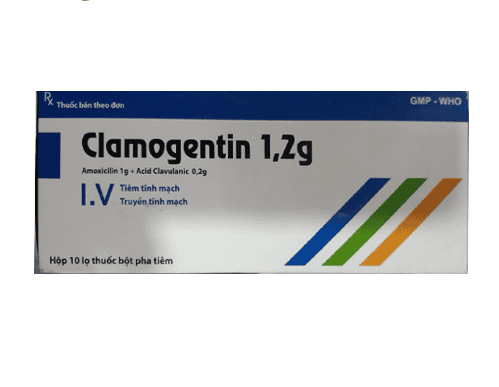This is an automatically translated article.
Fyranco is prepared in the form of lyophilized powder and solvent for injection or infusion. Teicoplanin is used in the prevention and treatment of a number of different bacterial infections.
1. Uses of the drug Fyranco
Fyranco 400mg drug has the main ingredient is 400mg Teicoplanin and excipients. Fyranco is an injectable antibiotic with mainly antibacterial activity that can be administered intramuscularly and intravenously every day. The main active ingredient Teicoplanin in Fyranco is a glycopeptide, which is active against both anaerobic and gram-positive aerobic bacteria. The antibacterial activity of this ingredient is similar to vancomycin.
Indications for use of Fyranco drug in the following cases:
Treatment of moderate to severe gram-positive infections and gram-positive infections in penicillin-allergic patients: Heart infections (endocarditis), bacterial infections skin and soft tissue infections, bone and joint infections (osteomyelitis), respiratory tract infections, urinary tract infections, peritonitis due to continuous peritoneal dialysis, sepsis syndrome, nosocomial sepsis, diarrhea Clostridium difficile diarrhea associated with antibiotic use; Prophylaxis during surgery in patients at high risk for gram-positive infections (transplantation, cardiac surgery). However, the following cases are not allowed to prescribe Fyranco:
Patients with hypersensitivity to teicoplanin; Pregnant and lactating women.
2. Usage and dosage of Fyranco
2.1. How to use Fyranco solution after reconstitution can be administered intramuscularly or intravenously. It can be given as a rapid intravenous injection (bolus injection) over 3-5 minutes or a slow intravenous infusion over 30 minutes. For infants, Fyranco is only given by intravenous drip. Physicians should pay close attention to the classification and severity of infection in order to determine the best dose of Teicoplanin.
Most patients infected with bacteria sensitive to Teicoplanin respond to treatment within 48 - 72 hours. The duration of treatment will depend on the severity of the infection, clinical and bacteriological progress. Basically, the patient needs to continue treatment for at least 3 days after the fever is gone or after the disappearance of clinical symptoms. For patients with osteoarthritis or endocarditis, treatment should be at least 3 weeks.
2.2. Dosage Dosage in adults:
Severe gram-positive infections: Initiate at 400 mg IV every 12 hours for 3 doses. Thereafter, a maintenance dose of 400 mg intramuscularly or intravenously per day is administered. The standard dose will be 400mg equivalent to an average dose of 6mg/kg body weight; Moderate Gram-positive infections: Initiate with 400 mg IV on the first day. Thereafter, a maintenance dose of 200 mg intravenously or intramuscularly per day is administered. The standard dose would be 200mg equivalent to an average dose of 3mg/kg body weight. For patients over 85 kg, the recommended dose should be consistent with the patient's weight of 3 mg/kg (moderate infections) or 6 mg/kg (severe infections). Higher doses may be used in some cases. The recommended dose for the treatment of endocarditis is 12 mg/kg/day to achieve serum concentrations not less than 20 mg/l; Prevention: 400 mg intravenously as a single dose or 6 mg/kg body weight in patients weighing more than 95 kg at the time of induction of anesthesia. During cardiac surgery, dose 2 should be administered approximately 24 hours after dose 1. For patients with diarrhea caused by Clostridium difficile associated with antibiotic use, the dose is 200mg / time x 2 times / day. Dosage in children (2 months and older):
Moderate Gram-positive infections: 10mg/kg IV every 12 hours for the first 3 doses. After that, the pediatric patient used a dose of 6mg/kg/day intramuscularly or intravenously; Severe gram-positive infections and leukopenia: 10mg/kg IV every 12 hours for the first 3 doses. After that, the pediatric patient used a dose of 10mg/kg/day intravenously or intramuscularly; The recommended dose for neonates is a single dose of 16 mg/kg IV on the first day of treatment. Thereafter, maintenance dose of 8mg/kg/day intravenously. Pediatric patients should be given intravenous drip over 30 minutes. Dosage in other subjects:
Elderly: Use the same dose as adults. For patients with impaired renal function, the dose of Fyranco should be controlled; Patients with renal impairment: No dose adjustment is required until the fourth day of Fyranco administration. Dosage should be adjusted to achieve serum concentrations not less than 10 mg/ml. Specifically: After the 4th day of treatment, patients with mild renal impairment (Clcr 40 - 60ml/min): Reduce the dose by half or use the starting dose every 2 days or take 1⁄2 of this dose daily; After the fourth day of treatment, patients with severe renal impairment (Clcr less than 40ml/min) and patients on hemodialysis: Reduce to 1⁄3 of the normal dose or use the starting dose every 3 days or use 13 daily doses. day; Patients on continuous peritoneal dialysis: Following intravenous administration of a single 400 mg initial dose, the recommended dose is 20 mg/l per bag of dialysis fluid for the first week, 20 mg/l for subsequent bags on 2nd week, 20mg/l for nocturnal sachets in week 3. At the same time, serum Teicoplanin levels should be checked periodically. There have been reports of overdoses of Fyranco in children. There are cases of children fussing, crying but most of them have no symptoms. In case of overdose, the patient will receive appropriate symptomatic treatment.
3. Side effects of the drug Fyranco
When using Fyranco, patients may experience some side effects such as:
Local reactions: Pain at the injection site, erythema, abscess at the injection site, thrombophlebitis; Hypersensitivity: Pruritus, fever, rash, shivering, anaphylactic reactions, anaphylaxis, bronchospasm, urticaria, angioedema, exfoliative dermatitis, erythema multiforme (including Stevens-Johnson syndrome) ; Gastrointestinal: Nausea, vomiting, diarrhea; Blood: neutropenia, leukopenia, thrombocytopenia, eosinophilia, reversible agranulocytosis (rare); Liver function: Increased serum transaminases, increased plasma alkaline phosphatase; Renal function: Renal failure, increased serum creatinine; Central nervous system: Headache, dizziness, convulsions when taking drugs in the arteries; Hearing, vestibular: Dizziness, vestibular disorders, hearing loss; Other: Superinfection (excessive increase in non-susceptible organisms).
4. Precautions when using Fyranco
Before and during the use of Fyranco, patients should note:
Use caution when using Fyranco in patients with a history of hypersensitivity to Vancomycin because it may lead to cross-hypersensitivity reactions. However, patients with a history of Red man's syndrome presenting with vancomycin are not contraindicated to Teicoplanin; There have been reports of some cases of thrombocytopenia with Teicoplanin and hearing, kidney and liver disorders. During treatment, it is necessary to periodically conduct hematological studies, to check the function of hearing, kidney and liver (especially in patients taking long-term drugs, patients with renal impairment, patients taking other drugs). other drugs may be toxic to hearing and kidneys); Teicoplanin use, especially with prolonged use, may cause overgrowth of non-susceptible organisms. The patient's condition should be reassessed periodically. If superinfection occurs while taking Fyranco, the patient can be given appropriate interventions; Teicoplanin should not be injected into the spinal cord; Fyranco should not be used if pregnancy is known or suspected, unless directed by a doctor after careful consideration of the benefits and risks; Avoid using Fyranco in nursing women, unless directed by your doctor after a benefit-risk assessment.
5. Fyranco drug interactions
Some drug interactions of Fyranco include: Due to the potential for side effects, Fyranco should be used with caution in patients who are taking ototoxic or nephrotoxic drugs such as: Amphotericin B , aminoglycosides, cisplatin, colistin, cyclosporin, ethacrynic acid and furosemide.
During the course of using Fyranco, the patient should absolutely follow all the instructions of the doctor to ensure the best therapeutic effect and limit the risk of adverse complications.
Please dial HOTLINE for more information or register for an appointment HERE. Download MyVinmec app to make appointments faster and to manage your bookings easily.













